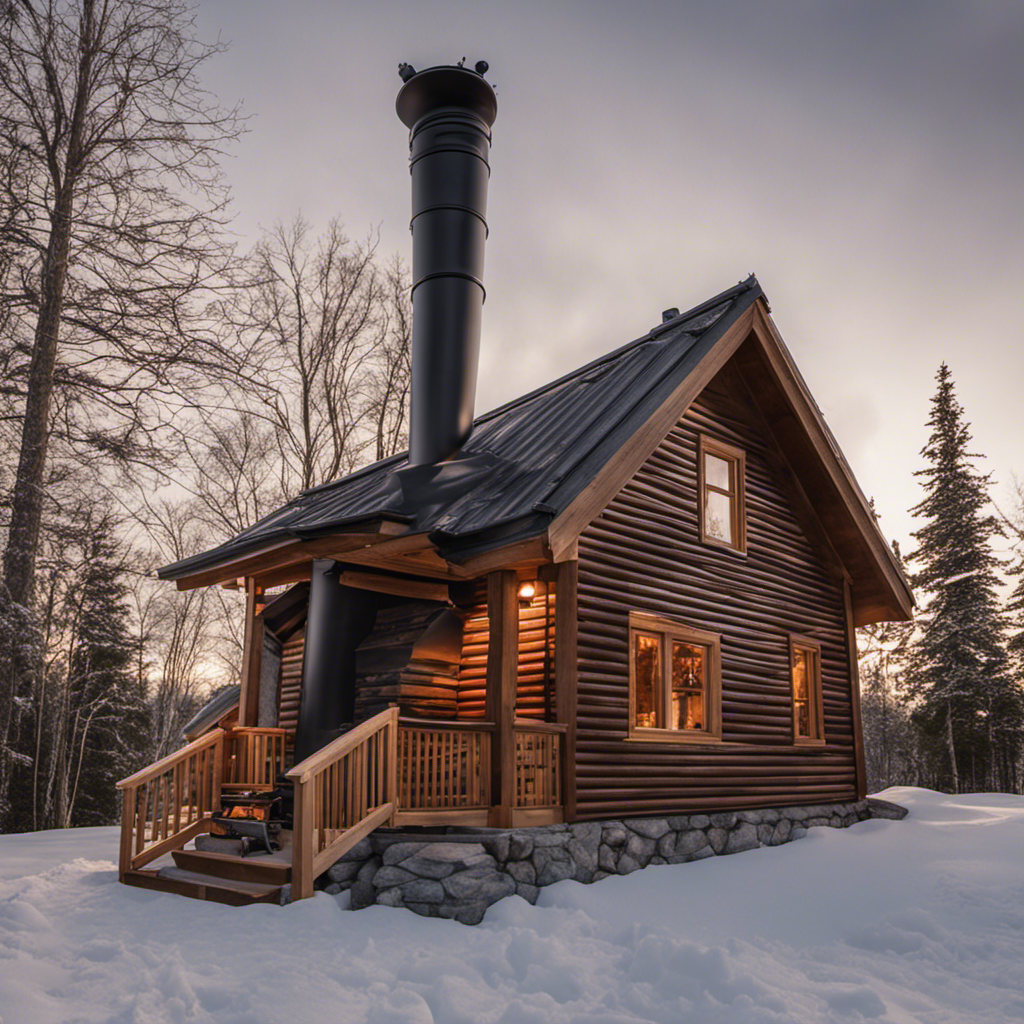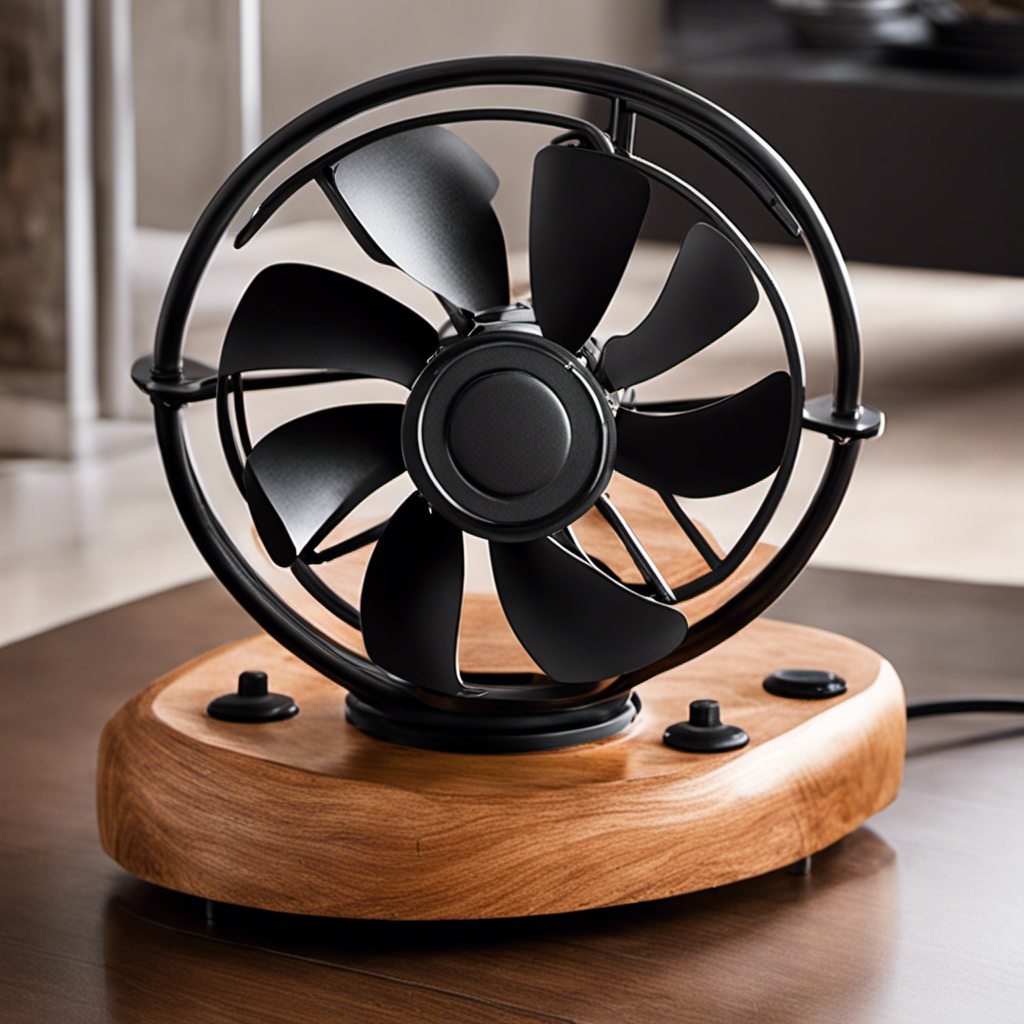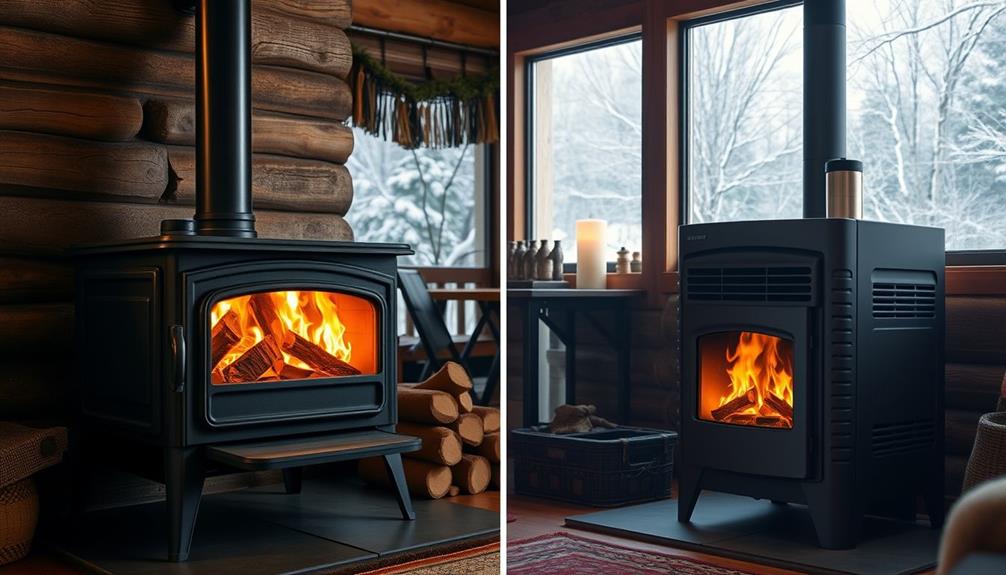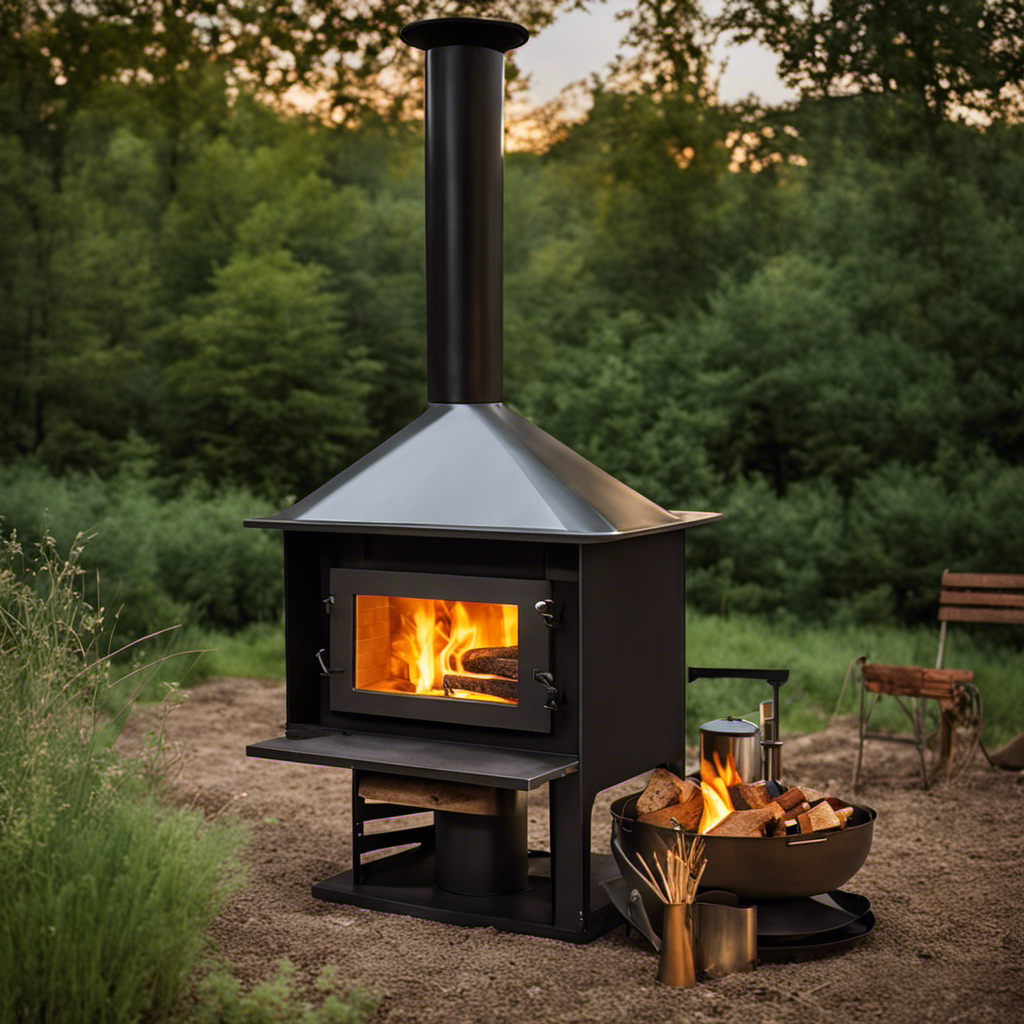I have always been fond of the cozy warmth and soothing crackles from a wood stove during the cold winter nights. However, the idea of needing to set up a chimney through the roof appeared intimidating.
However, after a bit of research and some trial and error, I discovered a step-by-step process that made it surprisingly manageable.
In this article, I’ll share my experience and guide you through the process of installing a wood stove chimney through the roof, so you too can enjoy the beauty and functionality of a wood stove in your home.
Key Takeaways
- Conduct a thorough roof inspection to ensure structural integrity, looking for signs of damage or decay in rafters or trusses, sagging, cracks, or water damage.
- Maintain a minimum clearance of 3 feet from combustible materials and install a chimney cap and spark arrestor for added safety.
- Gather necessary tools and materials such as a ladder, measuring tape, plumb bob, chalk line, and reciprocating saw, and wear protective gear.
- Plan and mark the chimney route carefully, considering distance from wood stove to ceiling and nearby combustible materials, as well as compliance with local regulations for ventilation and safety.
Assessing Roof Structure and Clearance
I need to make sure the roof structure can support the weight of the wood stove chimney and that there’s enough clearance from any combustible materials. Before installing a wood stove chimney through the roof, it’s important to conduct a thorough roof inspection to ensure its structural integrity.
Start by examining the rafters or trusses to ensure they’re in good condition and free from any signs of damage or decay. Look for any sagging or cracks, as these could indicate a weakened structure. Additionally, check for any water damage, as this can compromise the stability of the roof.
Once you’ve determined that the roof structure is sound, you need to consider clearance from combustible materials. It’s essential to maintain a safe distance between the wood stove chimney and any nearby flammable objects such as insulation, roof decking, or wooden beams. The National Fire Protection Association (NFPA) recommends a minimum clearance of 3 feet from the chimney to any combustible materials. This clearance is necessary to prevent heat transfer and reduce the risk of fire.
To ensure safety, it’s also important to follow other safety precautions, such as installing a chimney cap to prevent debris or animals from entering the chimney. Additionally, consider using a spark arrestor to prevent sparks from igniting nearby combustible materials.
Gathering the Necessary Tools and Materials
To get started, I’ll need a ladder, measuring tape, plumb bob, chalk line, and a reciprocating saw. These tools are essential for installing a wood stove chimney through the roof.
Choosing the right chimney pipe is crucial for a successful installation. Make sure to select a pipe that’s compatible with your wood stove and meets the necessary safety standards. Look for a pipe that’s made of durable materials and has proper insulation to prevent heat transfer.
Safety precautions during installation are of utmost importance. Before you begin, ensure that you’ve protective gear, such as gloves and goggles, to protect yourself from any potential hazards. Additionally, make sure to follow all local building codes and regulations to ensure a safe and compliant installation.
Now that we’ve gathered the necessary tools and materials and understand the importance of safety, let’s move on to the next step: planning and marking the chimney route.
Planning and Marking the Chimney Route
As I map out the path for the chimney, it’s important to consider the most direct route that ensures proper ventilation and complies with local regulations. To do this, I need to measure the distances from the wood stove to the roof and determine the size of the chimney that will best suit my needs.
First, I measure the distance from the wood stove to the ceiling. This will determine the height of the chimney that needs to pass through the roof. I also measure the distance from the stove to any nearby combustible materials, such as walls or furniture, to ensure the proper clearance is maintained.
Next, I measure the distance from the ceiling to the roof. This will determine the length of the chimney pipe that needs to be installed. It’s important to choose the right chimney size to ensure optimal airflow and efficient ventilation. A chimney that is too small can cause poor draft and smoke backup, while a chimney that is too big can lead to excessive heat loss.
To help visualize this process, here is a table that outlines the measurements and chimney size options:
| Measurement | Distance (in feet) | Chimney Size (in inches) |
|---|---|---|
| Stove to Ceiling | 8 | 6 |
| Ceiling to Roof | 10 | 8 |
Based on these measurements, I would need a 6-inch chimney pipe for the distance between the stove and the ceiling, and an 8-inch chimney pipe for the distance between the ceiling and the roof.
Cutting and Framing the Roof Opening
Now that I’ve planned and marked the chimney route, it’s time to move on to the next step: cutting and framing the roof opening.
This is a crucial part of the installation process, as it determines the stability and structural support for the chimney.
To begin, I’ll carefully measure and mark the dimensions of the opening on the roof, ensuring that it aligns with the chimney route.
Then, using a reciprocating saw, I’ll cut through the roof, making sure to follow the marked lines precisely.
Roofing Material Compatibility
I’ve found that it’s crucial to ensure the roofing material is compatible with the wood stove chimney installation. The right choice of roofing material can make a significant difference in the long-term performance and weatherproofing of your chimney.
Here are some key factors to consider when selecting the roofing material:
- Durability: Choose a material that can withstand the elements and has a long lifespan.
- Heat resistance: Opt for a roofing material that can handle the high temperatures emitted by the wood stove chimney.
- Compatibility: Ensure the roofing material is compatible with the chimney flashing and can be properly sealed to prevent leaks.
- Easy installation: Select a roofing material that’s easy to work with and can be installed without compromising the integrity of the roof.
- Aesthetic appeal: Consider the overall look and feel of the roofing material to ensure it complements the style of your home.
Structural Support Considerations
To ensure the safety and stability of the installation, it is important to consider the structural support requirements for the wood stove chimney. When installing a chimney through the roof, there are a few key factors to consider. First, you need to determine the structural load that the chimney will place on the roof. This can be calculated by considering the weight of the chimney itself and the additional weight of the flue liner and insulation. Additionally, the roof pitch is an important consideration as it affects the angle at which the chimney penetrates the roof. A steeper roof pitch may require additional support to ensure the chimney remains stable. It is crucial to consult with a professional to determine the specific structural support requirements for your wood stove chimney installation.
| Structural Load | Roof Pitch |
|---|---|
| Heavy | Steep |
| Medium | Moderate |
| Light | Low |
| Heavy | Steep |
| Medium | Moderate |
Proper Flashing Installation
When considering proper flashing installation for my wood stove chimney, it’s important to consult with a professional to ensure stability and safety. Flashing is crucial for protecting the area where the chimney meets the roof from water leaks. To maintain flashing, regular inspections are necessary to identify any signs of damage or deterioration.
Here are some common flashing issues and troubleshooting steps:
- Leaks: Check for gaps or cracks in the flashing and apply caulk or roofing cement to seal them.
- Rust: Remove any rust and apply a rust-resistant primer and paint to protect the flashing.
- Loose flashing: Secure loose flashing by using roofing nails or screws.
- Improper installation: If flashing wasn’t installed correctly, consult a professional to re-install it properly.
- Debris buildup: Clear any debris, such as leaves or branches, that may accumulate around the flashing to prevent clogs and water damage.
Installing the Chimney Flashing and Roof Brackets
To install the chimney flashing and roof brackets, I start by positioning the flashing around the chimney pipe and securing it to the roof with roofing nails.
Next, I attach the roof brackets to the roof, making sure they’re properly aligned and securely fastened.
This step is crucial for providing stability and support to the chimney pipe, ensuring a safe and secure installation.
Flashing Types and Materials
I prefer using flexible flashing made of EPDM rubber for the wood stove chimney installation. This type of flashing is highly durable and can withstand extreme temperatures, ensuring a long-lasting and effective seal around the chimney.
When it comes to flashing installation techniques, there are a few key steps to follow:
- Start by measuring and marking the area where the flashing will be installed.
- Cut the EPDM rubber flashing to the appropriate size, ensuring it extends at least 6 inches up the chimney and 12 inches onto the roof.
- Apply a layer of roofing cement to the area where the flashing will be placed.
- Secure the flashing to the chimney and roof using roofing nails or screws.
- Finally, seal any gaps or edges with additional roofing cement to prevent water leakage.
Proper Bracket Installation
Using a sturdy bracket made of durable metal is essential for properly supporting the weight of the chimney pipe. When installing the bracket, it’s crucial to consider its position and stability.
Here is a step-by-step guide on how to install the bracket correctly:
-
Determine the ideal position for the bracket. It should be located just below the roofline, where the chimney pipe will pass through.
-
Mark the position on the wall or roof using a pencil. Ensure that the bracket is level with the ground for proper support.
-
Drill pilot holes at the marked position, making sure they’re deep enough to securely hold the bracket.
-
Attach the bracket to the wall or roof using appropriate screws, ensuring a tight fit.
-
Test the bracket’s stability by gently pushing and pulling it. If any movement is detected, reinforce the attachment points or choose a more secure location.
Assembling and Installing the Chimney Pipe Sections
I’m attaching the chimney pipe sections together before installing them through the roof. First, I gather all the necessary pipe sections and ensure they’re clean and free of any debris. Then, I connect the sections by inserting the male end of one section into the female end of the next section. I make sure to align the seams properly for a secure fit. Next, I tighten the locking bands or screws to hold the sections together firmly.
Now that the chimney pipe sections are assembled, I proceed to install them through the roof. Here are the steps I follow:
- Measure and mark the location for the chimney pipe on the roof.
- Cut a hole in the roof using a reciprocating saw or other appropriate tool. Make sure the hole is slightly larger than the diameter of the pipe.
- Apply a layer of high-temperature silicone sealant around the opening to create a watertight seal.
- Carefully insert the chimney pipe through the roof and align it with the hole.
- Secure the chimney pipe to the roof using appropriate brackets or supports.
Once the chimney pipe is securely installed, I move on to the next step of installing the chimney cap.
Inspecting and Testing the Chimney Installation
To ensure the chimney installation is safe and functional, I carefully inspect and test the entire setup.
First, I conduct a smoke test to check for any leaks or obstructions in the chimney. I start by closing all doors and windows in the area to prevent any air drafts. Then, I light a small fire in the wood stove and let it burn for a few minutes.
Next, I climb up onto the roof to examine the chimney from the outside. I check for any signs of smoke escaping from the chimney, such as cracks or gaps. If I notice any issues, I make the necessary repairs before proceeding.
After completing the smoke test, I measure the height of the chimney to ensure it meets the necessary requirements. I use a measuring tape or a laser level to determine the exact height from the roofline to the top of the chimney. This measurement is important to ensure proper draft and airflow.
If the chimney height is too short, it may not draw the smoke out effectively, leading to poor combustion and potential smoke backdraft. On the other hand, if the chimney is too tall, it may create excessive draft, causing the wood stove to burn too hot and potentially damaging the stove or chimney.
Frequently Asked Questions
How Much Does It Cost to Install a Wood Stove Chimney Through the Roof?
When it comes to installing a wood stove chimney through the roof, the cost can vary depending on several factors. These include the materials needed, the size and complexity of the installation, and whether you choose to do it yourself or hire a professional.
DIY installation may save you money initially, but hiring a professional ensures proper installation and reduces the risk of mistakes.
It’s important to consider these cost factors and weigh the pros and cons before making a decision.
Can I Install a Wood Stove Chimney Through a Metal Roof?
Can I install a wood stove chimney through a metal roof?
Yes, you can. Metal roofs are suitable for installing wood stove chimneys.
The first step is to measure and mark the location where the chimney will go.
Then, you’ll need to cut a hole in the metal roof using a jigsaw or reciprocating saw.
Next, you’ll attach a chimney flashing to the roof around the hole to ensure a watertight seal.
What Are the Safety Precautions to Consider When Installing a Wood Stove Chimney Through the Roof?
When installing a wood stove chimney through the roof, safety measures are crucial. It’s important to follow the proper installation process to ensure a secure and efficient chimney system.
Begin by selecting the right location on the roof and measuring the clearance distances.
Use a roof flashing kit to create a watertight seal and protect against leaks.
Install a chimney support box to provide stability and prevent any structural damage.
Always consult a professional if you’re unsure about any step in the process.
Are There Any Building Codes or Permits Required for Installing a Wood Stove Chimney Through the Roof?
Installing a wood stove chimney through the roof requires careful consideration of building code requirements and the permitting process. It’s crucial to ensure compliance with local regulations to guarantee safety and avoid potential issues down the line.
Building codes dictate specific guidelines for chimney installation, including clearance distances, materials, and structural support. Additionally, obtaining the necessary permits is essential to ensure that the installation meets all legal requirements and is inspected for compliance.
Overall, following these steps will ensure a successful and compliant installation.
Can I Install a Wood Stove Chimney Through a Sloped Roof or Does It Have to Be a Flat Roof?
Installing a wood stove chimney on a slanted roof is possible, but it requires careful planning and consideration.
There are alternative options for wood stove chimney installation, such as using a chimney kit that’s specifically designed for sloped roofs. These kits provide the necessary components and instructions for a safe and efficient installation.
It’s important to consult with a professional to ensure that all building codes and regulations are met for the installation process.
Conclusion
In conclusion, installing a wood stove chimney through the roof requires careful planning, precise measurements, and the right tools and materials.
It’s essential to assess the roof structure and clearance beforehand to ensure a safe and efficient installation.
By following the step-by-step directions provided in this article, you can successfully cut and frame the roof opening, install the chimney flashing and roof brackets, and assemble and install the chimney pipe sections.
Remember, patience and attention to detail are key to a successful installation.
Growing up surrounded by the vast beauty of nature, Sierra was always drawn to the call of the wild. While others sought the comfort of the familiar, she ventured out, embracing the unpredictable and finding stories in the heartbeat of nature.
At the epicenter of every remarkable venture lies a dynamic team—a fusion of diverse talents, visions, and passions. The essence of Best Small Wood Stoves is crafted and refined by such a trio: Sierra, Logan, and Terra. Their collective expertise has transformed the platform into a leading authority on small wood stoves, radiating warmth and knowledge in equal measure.











